:format(jpeg)/cloudfront-us-east-1.images.arcpublishing.com/tgam/DVL2MDC7UNE3FIG4T2K62ME2LU.jpg)
Lamborghini says the Huracan Sterrato is ‘the first super sports car designed for maximum driving pleasure even away from the asphalt on loose or dirt surfaces.’Handout
Unlike other successful species, the sports car has evolved to become less and less suited to its natural habitat, the road.
This evolutionary anomaly is not entirely the sports car’s fault. Roads seem to be getting worse, riddled with potholes, narrowed by construction, sporadic closures and endless traffic snarls.
Some people see fast cars as a menace, a species that deserves to die. But I love them and I believe they can be enjoyed responsibly on public roads. For that to happen, however, sports cars need to adapt to this new reality.
There’s a glimmer of hope in a pair of new machines from Porsche and Lamborghini, which take their inspiration from rough-terrain-loving rally cars rather than delicate, ground-hugging, pavement-bound Formula 1 race cars. The unreasonably expensive $250,000 Porsche 911 Dakar and Lamborghini’s Huracan Sterrato both look like they escaped from the Monte Carlo Rally. Think: more ground clearance, knobbly tires, extra lights and, most importantly, longer-travel suspension that should be ready to soak up potholes and nasty pavement.
The history of the sports car could have gone differently. What if the vision of Colin Chapman, founder of Lotus Cars and a proponent of lightweight, low-power and somewhat flimsy sports cars had won? Or, what if rally racing had become more popular than NASCAR and Formula One?
Instead, modern sports cars evolved to become more like circuit-racing machines, cars built for smooth tarmac, high speeds, big G-forces and the fastest possible lap times.
Germany’s Nordschleife circuit is the benchmark, where nearly all serious sports cars are honed and tested. Lap times there have tumbled. Anything under eight minutes was quick in the 1990s, but today the record is down to 6:30, nearly eclipsing the once-thought untouchable record set in 1983 by Stefan Bellof in a Porsche 956 prototype.
:format(jpeg)/cloudfront-us-east-1.images.arcpublishing.com/tgam/BCP3DKJQPBEU7A2RJJOSQUYGHA.jpg)
Porsche revealed a jacked-up, off-road 911 version called the Dakar at the 2022 Los Angeles Auto Show.Petrina Gentile/The Globe and Mail
The result is that modern sports cars have 600 or 800 horsepower, giant 19-, 20- or 21-inch lightweight alloy wheels that leave barely enough room to stretch the thinnest rubber tire under bulging fenders. (Those lovely wheels, by the way, can all too easily be turned into D-shaped paperweights by a rogue pothole, as I once found out driving a Ferrari in New Jersey.)
Modern sports cars can corner so hard and stick to the road with such Velcro-like tenacity that your neck will strain to keep your head up. They can accelerate to 100 kilometres an hour in less time than it takes to read this sentence. In fact, some of them would have already blasted past 200 by now. Such performance requires serious, heavy hardware – beefy chassis, brakes and wheel hubs.
:format(jpeg)/cloudfront-us-east-1.images.arcpublishing.com/tgam/NNKW4JYVZBACFNFEN3NCG7N5NA.jpg)
Porsche 911 DakarHandout
Fast, heavy cars need stiff springs and dampers to keep them under control, and that means – all too often – that passengers on rough roads get bounced around like they’re trapped in a tumble dryer.
It doesn’t need to be this way.
What if sports cars had evolved to become more like rally cars? Machines built not for smooth tarmac, but instead for gravel, dirt, bumps, ruts, sand, ice, snow and broken pavement – the real world, in other words.
Think of rally cars as the mutant offspring of a sports car and an SUV. And, given Canadian drivers’ near insatiable appetite for SUVs, Lamborghini and Porsche might be onto something with their new rally-inspired machines.
We want an EV that can get us to the mountains for less than $50,000
Before them, some niche automakers had the same idea. First there was U.K.-based company Ariel, with its skeletal Nomad off-road sports car, and Morgan, with its Plus Four CX-T that looked like something the British Army would have used during the Second World War to take on the German Afrika Korps. Scuderia Cameron Glickenhaus, a U.S.-based upstart founded by film director and Ferrari collector Jim Glickenhaus, is currently taking orders for the 008, a $100,000 build-it-yourself Baja buggy.
:format(jpeg)/cloudfront-us-east-1.images.arcpublishing.com/tgam/N7ZPXPCJGZHXXI3JW3FHHY2V5I.jpg)
U.K.-based Ariel Motor Company offers a skeletal Nomad off-road sports carHandout
The new rally-inspired cars from Porsche and Lamborghini are wildly expensive and highly exclusive – Porsche is building just 2,500 examples of the 911 Dakar – but if they prove successful, more automakers may see the light.
It makes little sense to ruin a perfectly practical SUV by making it “sporty,” usually a euphemism for expensive and uncomfortable. Conversely, it makes plenty of sense to give a sports car an added dose of SUV practicality.
Imagine a lifted Mazda MX-5 with all-road ability that owners need not store in a garage when the snow piles up, or a Baja-edition Ford Mustang. Subaru has the rally-racing heritage to pull off a jacked-up all-terrain BRZ; the Internet is already littered with fan-made concept images.
A high-riding BMW M2 with a six-speed manual, long-travel Ohlins shock absorbers, high-sidewall tires wrapped over gravel OZ wheels and some mud flaps (to protect the paint, naturally) would be pretty close to my dream car.
Could this be the beginning of a trend? Those who wish to see the sports car survive can only hope so.
Shopping for a new car? Check out the new Globe Drive Build and Price Tool to see the latest discounts, rebates and rates on new cars, trucks and SUVs. Click here to get your price.
